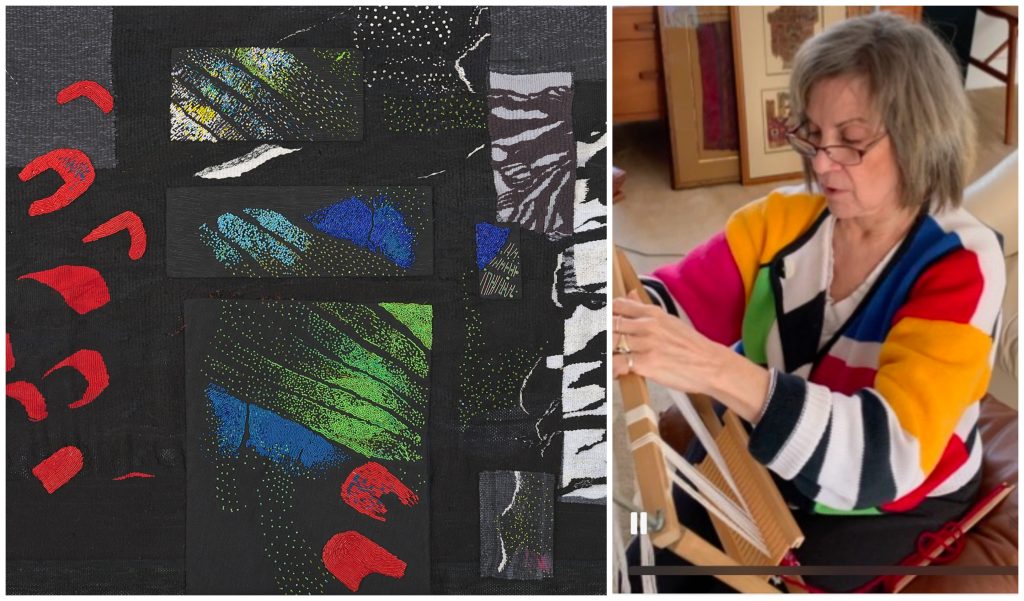by Linda Downs
Thirty tapestries of Rowen Schussheim-Anderson at Preston Jackson Gallery in Peoria transform an ancient medium into masterful images of brilliant saturated colors, undulating lines and forms that echo nature. While maintaining the traditional grid of the linen warp, it disappears under varied surfaces of subtle to saturated planes of color that vary in density through the use of the wool, silk, cotton, and rayon yarn. Elegant lines traverse and hug the forms as if they had been painted by a brush. These works transport the viewer into a world of brilliance and wonder.
Schussheim-Anderson shares Abstract Expressionists’ focus on the expressive use of color and shape as the ‘subject’ of works of art. Ever since 1911 when Matisse’s Red Studio so shocked the art world that students at the School of the Art Institute of Chicago burned a reproduction of it, color became predominant in modern art. However, unlike the Expressionists who drew their inspiration for color, first, from their own palette and later from American advertising, Schussheim-Anderson was additionally inspired by West African and Andean textiles.
As a professor of art at Augustana College, she organized student trips to Burkina Faso, Ghana, Senegal, Togo, Benin and Morocco as well as Argentina, Ecuador, Chile, Brazil, and Peru. They met with indigenous textile artists and contemporary artists such as Maximo Laura, whose traditional and new techniques inspired both the teacher and her pupils. The textiles of brilliantly colored clothes in West Africa added to Schussheim-Anderson’s pallet. And her interest in varied weaving materials such as jute, raffia, wild silk, bark cloth as well as beads, feathers, glass and jewelry of Ghana, Togo and Benin inspired her and her students to heighten their designs.
What Schussheim-Anderson has achieved in her work is a distinct style that combines the Expressionists predominance of color, saturated with the intensity of African textiles and the pastoral quality of the rolling and verdant landscapes of the Midwest. Growing up in Washington, D.C. with The Textile Museum in her neighborhood, studying art at Arizona State University and becoming familiar with Native American Indian textiles; teaching in the project implemented by Ruth Asawa at the Alvarado School Workshop that reached 50 public schools in San Francisco; and settling in Davenport, Iowa to teach at Augustana College where nature is so prominent that discussing the quality of the clouds is part of daily exchanges, Schussheim-Anderson’s rich background comes into focus in her masterful work.
This new work radiates an uplifted and anticipatory character, perhaps related to the freedom of her new retirement. Several works address the anticipation and fulfillment of travel.
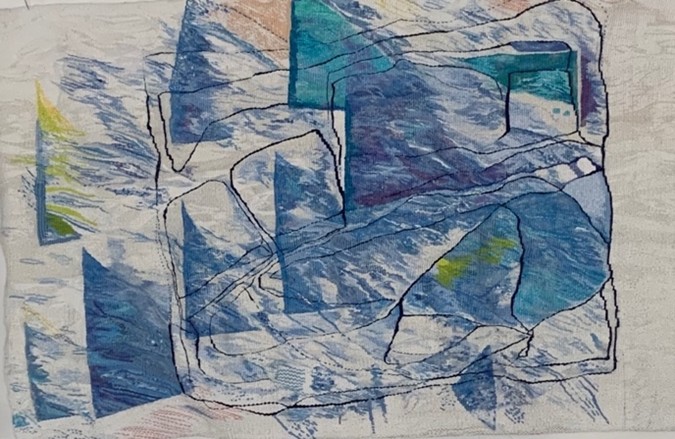
DAWN DREAMS, 45 x 28”, wool, linen, cotton, silk, 2024
In Dawn Dreams large naturally-rounded boulder-like forms are encircled by a soft blanket-shape and pushed along by streaming lines that are wistfully wind-blown over triangular blue forms in the background. The gentle and soft grey-blue colors may signal a good sleep.
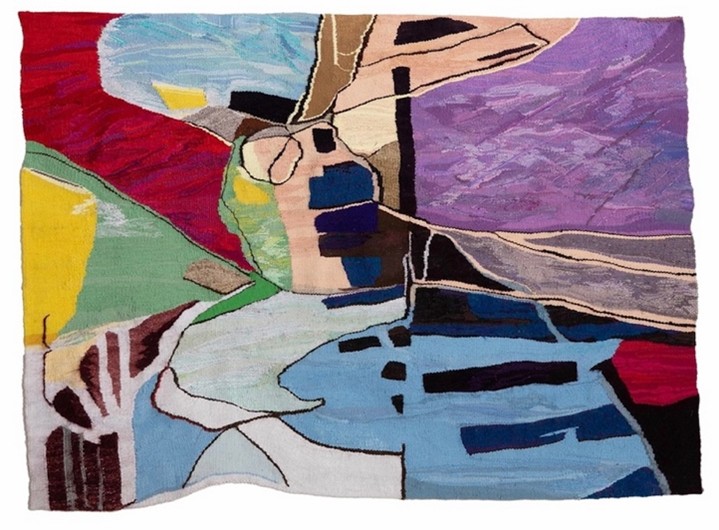
GOING PLACES, 40.5 X 32”, wool, linen, cotton, silk, 2025
Going Places radiates with the excitement of travel. The central circle, which can be read as both an abstracted city or an eye-popping face, is surrounded with large radiating rectangles of magenta, baby blue, green and yellow and violet reaching out into space.
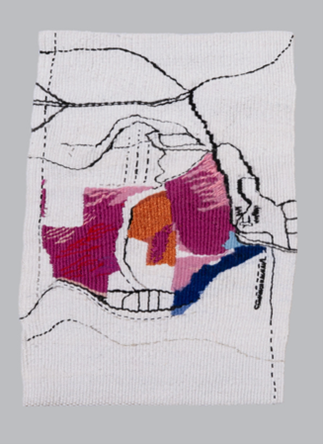
PROCEED TO THE ROUTE, 10 X 13.5”, wool, linen, cotton, silk, 2024
Proceed to the Route is reminiscent of cellular maps but this map designates an enticing end-point of magenta, blue, black on a map-white background.
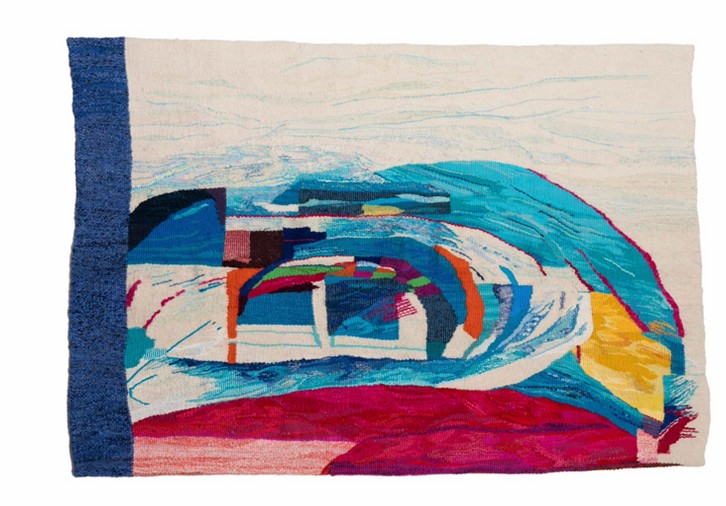
ARRRIVED, 48.5 x 29”, wool, linen, cotton, silk, 2025
Arrived presents pools of refreshing blue over a hot red form. A wonderful feeling of the exhilarating relief occurs when visually plunging into the cool blues over the hot red shape below.
These works are closest to paint on canvas where the level of the warp is maintained but many other works undulate in raised and lowered sections and are enhanced with the glint of glass beads, spools and metal threads catching the light and the eye.
Rowen Schussheim-Anderson has established herself as one of the American masters of tapestry. This exhibition only reinforces her status as an artist that directly engages viewers into her world of deep, rich color, expressive line and immediately relatable images.
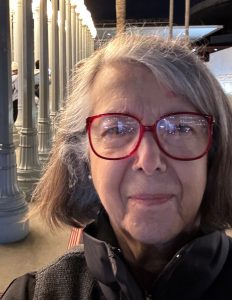
The author of this essay, Linda Downs, served as Department Head of the Education Department at the Detroit Institute of Arts, Head of Education for the National Gallery of Art in Washington, DC, and Executive Director of both The Figge Art Museum in Davenport, Iowa and the College Art Association.

